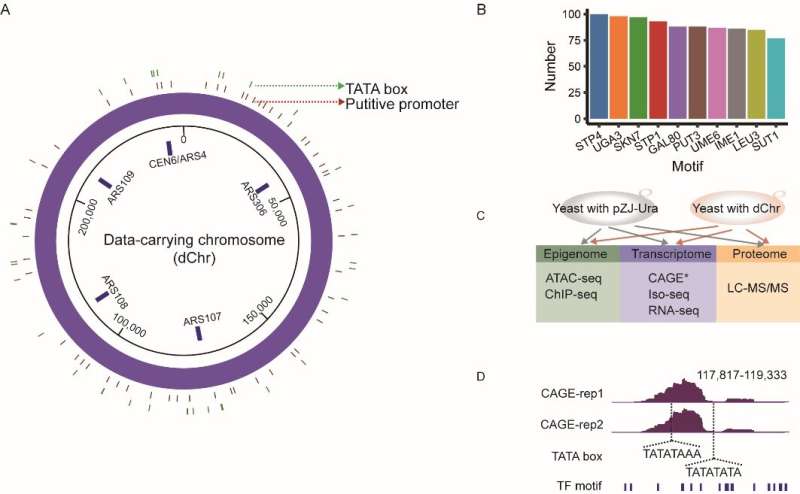Exogenous artificial DNA forms chromatin structure with active transcription in yeast

Previously, researchers from Tianjin University designed and created a 254 kb digital data carrying artificial chromosome in yeast. This work "is a key proof-of-concept that demonstrated how artificial chromosomes can be used for data storage in a way that is robust and essentially free to copy." It broke through the limitation for the total length of encoded data within a single cell of just a few thousand base pairs per genome. The intracellular biological characteristics of this completely exogenous digital data-carrying chromosome (dChr) have received widespread attention.
The dChr was designed for data storage purpose. Researchers applied the superposition method with sparsified low-density parity-check (LDPC) codes and pseudo-random sequences to encode the image information. No extra caution was taken into consideration to avoid introducing potential genetic elements with biological activities such as promoters, regulatory sequences, protein/RNA binding and coding sequences.
"Many genetic elements were generated unintentionally. We found 54 putative promoters, 36 TATA boxes, and a large number of transcription factor-binding motifs that were distributed in the dChr, " said Dr. Jianting Zhou, the first author for this work. By using CAGE-seq (Cap Analysis of Gene Expression AND deep Sequencing), 20 de novo TSSes (Transcriptional Start Sites) in the dChr were detected, as well as TATA boxes near them.
The above data suggested that there are TSSes mixed into DNA sequence of the dChr. PolII may bind to these TSSes and further activate the transcription machine, producing stable mRNAs. The results also consistent with the high H3K4 tri-methylation modification and chromatin accessibility data in the dChr. The dChr formed chromatin with histones in vivo, and the artificial chromatin displayed an active epigenetic state with high chromatin accessibility and H3K4me3 levels. As for three-dimensional structure of the dChr, the researchers inspected the trans-interaction matrix and confirmed the yeast chromosomes exhibited a Rabl configuration.
These encouraging results confirmed that the exogenous dChr was not naked DNA in yeast, and it wrapped around histones, contributing to the formation of chromatin with three-dimensional structures. This study deepens our understanding of the activity of the fully exogenous YAC in the yeast cells, and guides researchers to construction of next generation of artificial chromosomes for data storage.
The research was published in Science China Life Sciences.
More information: Jianting Zhou et al, Exogenous artificial DNA forms chromatin structure with active transcription in yeast, Science China Life Sciences (2021). DOI: 10.1007/s11427-021-2044-x
Journal information: Science China Life Sciences
Provided by Science China Press


















